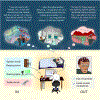Real-time dialogue between experimenters and dreamers during REM sleep
- PMID: 33607035
- PMCID: PMC8162929
- DOI: 10.1016/j.cub.2021.01.026
Real-time dialogue between experimenters and dreamers during REM sleep
Abstract
Dreams take us to a different reality, a hallucinatory world that feels as real as any waking experience. These often-bizarre episodes are emblematic of human sleep but have yet to be adequately explained. Retrospective dream reports are subject to distortion and forgetting, presenting a fundamental challenge for neuroscientific studies of dreaming. Here we show that individuals who are asleep and in the midst of a lucid dream (aware of the fact that they are currently dreaming) can perceive questions from an experimenter and provide answers using electrophysiological signals. We implemented our procedures for two-way communication during polysomnographically verified rapid-eye-movement (REM) sleep in 36 individuals. Some had minimal prior experience with lucid dreaming, others were frequent lucid dreamers, and one was a patient with narcolepsy who had frequent lucid dreams. During REM sleep, these individuals exhibited various capabilities, including performing veridical perceptual analysis of novel information, maintaining information in working memory, computing simple answers, and expressing volitional replies. Their responses included distinctive eye movements and selective facial muscle contractions, constituting correctly answered questions on 29 occasions across 6 of the individuals tested. These repeated observations of interactive dreaming, documented by four independent laboratory groups, demonstrate that phenomenological and cognitive characteristics of dreaming can be interrogated in real time. This relatively unexplored communication channel can enable a variety of practical applications and a new strategy for the empirical exploration of dreams.
Keywords: REM sleep; consciousness; dreams; interactive dreaming; lucid dream; sensory processing; sleep learning; sleep mentation; targeted memory reactivation; two-way communication.
Copyright © 2021 The Authors. Published by Elsevier Inc. All rights reserved.
Conflict of interest statement
Declaration of interests The authors declare no competing interests.
Figures



 ) and reported the answer ‘4’ with eye signals. I looked for a tool that could flash, and I found a round bowl full of water. The water flashed (like a fish tank light that one turns on and off). I again saw a signal, but was not able to identify it. The bowl broke because I accidentally let it fall while trying to decode the flashes. I left the room, trying to find something else that could flash, and went outside and looked up to the clouds. There was yellow sunlight and light gray clouds. I saw variations in the brightness, clouds drifting past quickly, but again, unfortunately, I could not decipher a flashing signal. It was too fast to decode, but I knew that these were math problems.”
) and reported the answer ‘4’ with eye signals. I looked for a tool that could flash, and I found a round bowl full of water. The water flashed (like a fish tank light that one turns on and off). I again saw a signal, but was not able to identify it. The bowl broke because I accidentally let it fall while trying to decode the flashes. I left the room, trying to find something else that could flash, and went outside and looked up to the clouds. There was yellow sunlight and light gray clouds. I saw variations in the brightness, clouds drifting past quickly, but again, unfortunately, I could not decipher a flashing signal. It was too fast to decode, but I knew that these were math problems.”

Comment in
-
Sleep: Opening a portal to the dreaming brain.Curr Biol. 2021 Apr 12;31(7):R352-R353. doi: 10.1016/j.cub.2021.02.016. Curr Biol. 2021. PMID: 33848493
-
Two-Way Communication in Lucid REM Sleep Dreaming.Trends Cogn Sci. 2021 Jun;25(6):427-428. doi: 10.1016/j.tics.2021.04.004. Epub 2021 Apr 17. Trends Cogn Sci. 2021. PMID: 33879421
References
-
- Horikawa T, Tamaki M, Miyawaki Y, and Kamitani Y (2013). Neural decoding of visual imagery during sleep. Science 340, 639–642. - PubMed
-
- Dresler M, Koch SP, Wehrle R, Spoormaker VI, Holsboer F, Steiger A, Sämann PG, Obrig H, and Czisch M (2011). Dreamed movement elicits activation in the sensorimotor cortex. Curr. Biol 21, 1833–1837. - PubMed
Publication types
MeSH terms
Grants and funding
LinkOut - more resources
Full Text Sources
Other Literature Sources
Medical

